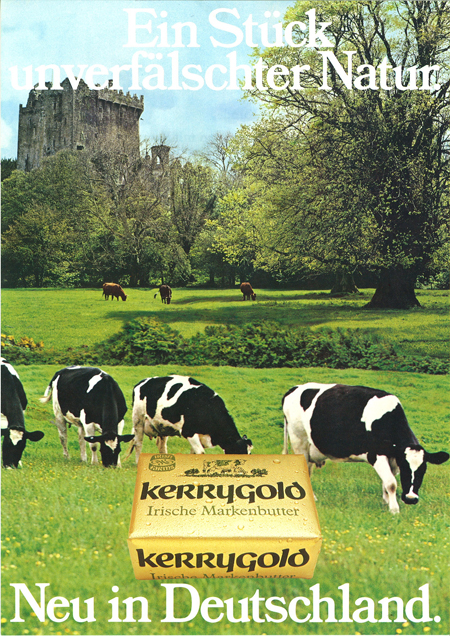Marketing Irish farming: from word of mouth, to print, to TV and social media. A very early image of the Kerrygold brand. Image via the Irish Dairy Board
Remember some of the cheesy lines from the classic TV ads for the Irish butter brand Kerrygold in the Eighties, such as ‘Who’s taking the horse to France?’ or ‘Well you could put a bit of butter on the spuds André’? A new YouTube campaign called ‘The Meadow Milk’ has launched to coincide with the 40th anniversary of the Kerrygold brand in Germany.
The YouTube campaign is being given an extra push today by the IDB. That’s because the board has just announced that it is injecting €10.5m to vamp up its production capabilities in Germany – but more on that later.
Back to the social media campaign ‘The Meadow Milk’ on YouTube. It features a quintet of videos. First off, there’s the A Day in the Life video featuring an Irish dairy farmer from Co Cavan by the name of David Cassidy.
Love of the land
On a daily basis, Cassidy and his family work on their farm to milk 80 dairy cows. As a third-generation farmer, Cassidy details in the video his love of the land and grass-based farming, and, of course, milk.
The Kerrygold videos on YouTube appear to be targeting export markets principally. Celebrating Rain, for instance, features Russian subtitles.
The videos also home in on the weather and climate in Ireland, the conditions in Ireland for growing grass, the farmers who contribute to the Kerrygold brand, plus animal welfare.
The ‘garden’ of Europe: Ireland, as often described by Germans
The Irish Dairy Board (IDB) is promoting Kerrygold’s social media push in particular today, as it has just announced that it is to pump €10.5m into its production facilities in Germany – to coincide with Kerrygold’s 40th anniversary of being in the German market.
Kerrygold is owned by the IDB, which itself is owned by Irish dairy processing co-operatives and dairy companies and – through them – by Irish dairy farmers.
The IDB said this morning that the €10.5m investment will be used to increase the capacity of the production facilities for Kerrygold in Germany.
More specifically, the IDB said the €10.5m will be targeted towards extending storage, packing, production facilities and new product development. The IDB employs 110 staff in Germany.
In bygone times – Kerrygold in Germany

Retro poster to promote Kerrygold in Germany in the early days of the IDB’s move into that export market for butter and other dairy products. Image via the IDB
Kevin Lane, CEO of the IDB, said that Germany has been the most successful export market for the IDB to date.
He said that, overall, turnover in Germany in 2013 will surpass €280m, describing it as a “record performance” for the business.
“The €10.5m investment we are announcing today is strategically very important for the IDB.
“Our base here allows us to further expand our business in Germany and throughout this region,” said Lane.
He said that the investment move would have spin-offs for IDB Deutschland, for IDB employees and – crucially – for Irish dairy farmers, who will have a bigger market for their milk.
“In the run up to 2015 and beyond, core established markets such as Germany, as well as new emerging markets, will be very important for the Irish dairy industry,” said Lane.
Abolition of the milk quota in 2015
The reason why 2015 is such a pivotal year is because that is when the milk quota will be abolished in Ireland for dairy farmers. The ending of the milk quota, which came into force under the Common Agricultural Policy (CAP) in Europe, will mean that dairy farmers operating in Ireland will be able to supply more milk to the IDB. And, in turn, the IDB will be aiming to export this excess milk, not needed in Ireland, into other markets.
According to the IDB, Kerrygold is Germany’s No 1 butter brand, with a 17pc market share and over a 50pc branded share.
Close to 200m packs of Kerrygold butter is sold in over 23,000 outlets each year apparently, with the IDB describing this as enough butter to stretch from Dublin to Berlin, 14 times.
Trading in Europe
The Kerrygold brand was first launched in just a handful of stores in Germany in 1973 – the year in which Ireland joined the European Economic Community (EEC), also known as Europe’s Common Market at the time.
In 1993, the Common Market was renamed the European Community. Then, in 1993, the European Community came under the wing of the European Union’s three pillars, following the Maastricht Treaty.